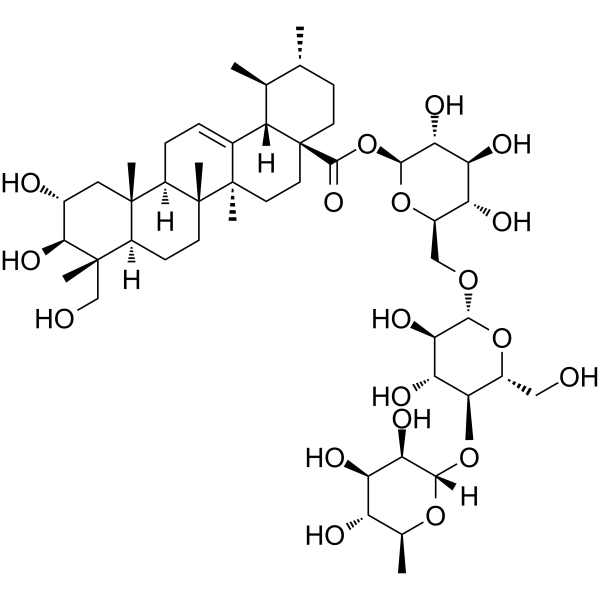天然产物 糖类和糖苷 Saccharides and Glycosides
Asiaticoside;(Synonyms: 积雪草苷) 纯度: 99.72%
Asiaticoside 是从积雪草中分到的三萜皂苷化合物,在瘢痕疙瘩成纤维细胞中,通过活化 Smad7,抑制 TGF-βRI 和 TGF-βRII,抑制 TGF-β/Smad 信号通路;Asiaticoside 具有抗氧化、抗炎、抗溃疡等功效。

Asiaticoside Chemical Structure
CAS No. : 16830-15-2
| 规格 | 价格 | 是否有货 | 数量 |
|---|---|---|---|
| Free Sample (0.1-0.5 mg) | ; | Apply now | ; |
| 10;mM;*;1 mL in DMSO | ¥550 | In-stock | |
| 10 mg | ¥500 | In-stock | |
| 50 mg | ¥1800 | In-stock | |
| 100 mg | ¥3100 | In-stock | |
| 200 mg | ; | 询价 | ; |
| 500 mg | ; | 询价 | ; |
* Please select Quantity before adding items.
Asiaticoside 相关产品
bull;相关化合物库:
- Natural Product Library Plus
- Bioactive Compound Library Plus
- Apoptosis Compound Library
- Immunology/Inflammation Compound Library
- Metabolism/Protease Compound Library
- NF-kappa;B Signaling Compound Library
- Stem Cell Signaling Compound Library
- TGF-beta/Smad Compound Library
- Wnt/Hedgehog/Notch Compound Library
- Natural Product Library
- Anti-Cancer Compound Library
- Human Endogenous Metabolite Compound Library
- Anti-Aging Compound Library
- Antioxidants Compound Library
- Glycoside Compound Library
- Oxygen Sensing Compound Library
- Anti-Cardiovascular Disease Compound Library
- Ferroptosis Compound Library
- Terpenoids Library
- Pyroptosis Compound Library
- Traditional Chinese Medicine Monomer Library
- FDA Approved amp; Pharmacopeial Drug Library
- Angiogenesis Related Compound Library
- Mitochondria-Targeted Compound Library
- Transcription Factor Targeted Library
- Food-Sourced Compound Library
| 生物活性 |
Asiaticoside, a trisaccaride triterpene from Centella asiatica, suppresses TGF-β/Smad signaling through inducing Smad7 and inhibiting TGF-βRI and TGF-βRII in keloid fibroblasts; Asiaticoside shows antioxidant, anti-inflammatory, and anti-ulcer properties. |
||||||||||||||||
|---|---|---|---|---|---|---|---|---|---|---|---|---|---|---|---|---|---|
| IC50 Target |
|
||||||||||||||||
| 体外研究 (In Vitro) |
Asiaticoside (0, 100, 250, and 500 mg/L) dose-dependently inhibits keloid fibroblasts proliferation. Asiaticoside (100, 250, and 500 mg/L) decreases the expression of collagen protein and mRNA, reduces the expression of TGF-bRI, TGF-bRII protein, and mRNA, increases the expression of Smad7, but does not affect Smad2, Smad3, Smad4, phosphorylated Smad2, and phosphorylated Smad3 in keloid fibroblasts[1]. Asiaticoside (12.5 and 50, and 25 and 50 µg/mL) prevents endothelial cells from hypoxia-induced inhibition of cell viability and NO production. Asiaticoside (50 µg/mL) also protects endothelial cells from hypoxia-induced apoptosis and upregulates and phosphorylation of AKT/eNOS in hypoxia-exposed HPAECs[2]. MCE has not independently confirmed the accuracy of these methods. They are for reference only. |
||||||||||||||||
| 体内研究 (In Vivo) |
Asiaticoside (50 mg/kg daily) blocks the development of hypoxic pulmonary hypertension (PH), cardiovascular remodeling and endothelial cell injury in rats with pulmonary hypertension[2]. Asiaticoside (5, 15 or 45 mg/kg, p.o.) improves the learning and memory deficit, protects hippocampi against the impairment, decreases Aβ deposits in the hippocampus, and ameliorates impaired subcellular structure in rats treated with Aβ oligomers[3]. MCE has not independently confirmed the accuracy of these methods. They are for reference only. |
||||||||||||||||
| 分子量 |
959.12 |
||||||||||||||||
| Formula |
C48H78O19 |
||||||||||||||||
| CAS 号 |
16830-15-2 |
||||||||||||||||
| 中文名称 |
积雪草苷 |
||||||||||||||||
| 运输条件 |
Room temperature in continental US; may vary elsewhere. |
||||||||||||||||
| 储存方式 |
|
||||||||||||||||
| 溶解性数据 |
In Vitro:;
DMSO : 50 mg/mL (52.13 mM; Need ultrasonic) 配制储备液
*
请根据产品在不同溶剂中的溶解度选择合适的溶剂配制储备液;一旦配成溶液,请分装保存,避免反复冻融造成的产品失效。 In Vivo:
请根据您的实验动物和给药方式选择适当的溶解方案。以下溶解方案都请先按照 In Vitro 方式配制澄清的储备液,再依次添加助溶剂: ——为保证实验结果的可靠性,澄清的储备液可以根据储存条件,适当保存;体内实验的工作液,建议您现用现配,当天使用; 以下溶剂前显示的百
|
||||||||||||||||
| 参考文献 |
|
| Cell Assay [1] |
Cells are seeded at a density of 2-9 × 104 cells/mL into 24-well plates for cell viability, 60-mm plates for RNA and protein analysis in DMEM containing 10% FBS (DMEM/10% FBS). After 24 h, medium is removed and cells are placed in serum-free DMEM. After 48 h, different concentrations of Asiaticoside in DMEM/10% FBS are added simultaneously to cells. Control cells are grown in DMEM/10% FBS without the addition of Asiaticoside. At different time points, the fibroblasts are harvested for analysis[1]. MCE has not independently confirmed the accuracy of these methods. They are for reference only. |
|---|---|
| Animal Administration [3] |
Rats[3] Sprague-Dawley rats are used to establish the Alzheimer’s disease (AD) model. Asiaticoside is administered orally at 5, 15 or 45 mg/kg body weight per day for 7 days. The learning and memory function of the rats are evaluated by the MWM test 7 days after surgery. The swimming pool (180 cm in diameter) is maintained at 22-24°C, and divided into four quadrants with equal size. A hidden platform is placed in the center of one quadrant. Each of the cardinal points of these four quadrants is randomLy selected as the start location. On the pre-test day, rats are allowed to swim freely for 120 sec. During the test (days 1-4), each rat is subjected to 8 trials each day. The trial begins when a rat is placed in the pool, and ended when the rat finds the platform. The escape latency is recorded. If a rat fails to find the platform within 120 sec, the trial is terminated and the escape latency is recorded as 120 sec, and the rat is guided to the platform. On day 5, the swimming path is recorded by a video recording system, and the digital images are analyzed by the water maze software. In addition, the probe test is performed, in which the platform is removed, and the rat is allowed to swim freely in the pool for 120 sec. The swimming time in the target quadrant is recorded[3]. MCE has not independently confirmed the accuracy of these methods. They are for reference only. |
| 参考文献 |
|

